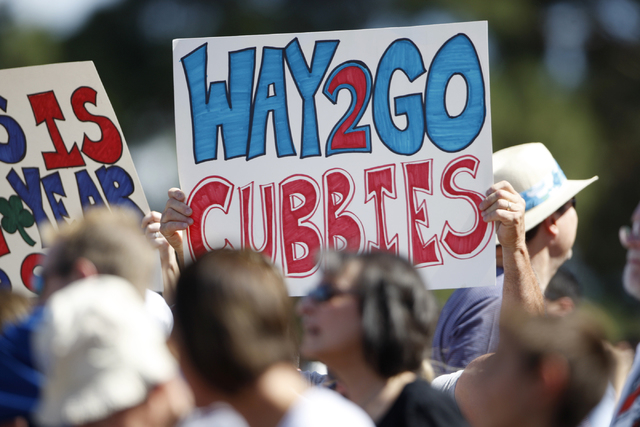Cubs’ College of Coaches wasn’t so dumb

They have so many young, talented players that Joe Maddon, the enthusiastic new manager of the Chicago National League ballclub — who did not accompany some of his regulars and a bunch of other guys wearing jersey numbers in the 70s to Las Vegas for Big League Weekend at Cashman Field — has taken to calling the team Cubs University.
Which sort of rings a bell among baseball historians and admirers of the trivial.
Back in the flannel uniform days, the Chicago National League ballclub did not have a field manager.
It had a College of Coaches.
Starting with the 1961 season, P.K. Wrigley, the Cubs’ spendthrift owner, decided the team no longer should have a field manager.
Instead, it would have an eight-man committee of coaches. And that every month or so, one of these fungo hitters would become head coach. The others would alternate between first and third base or the bullpen, or be assigned elsewhere within the Cubs organization.
This was supposed to lead to a uniform style of play throughout the system. Instead of one manager, every player in the Cubs’ organization would benefit from the combined expertise of eight coaches and fungo hitters.
Thus was born the College of Coaches.
Mr. P.K. Wrigley thought this was a better idea than spearmint chewing gum.
One has a feeling that if the St. Louis Cardinals had a College of Coaches during Tony La Russa’s run, and La Russa had managed the Redbirds one month and then been assigned to, say, their Class A team at Peoria in the Midwest League, he probably wouldn’t have gone for it.
In addition to having a College of Coaches — for those scoring at home, the first faculty included El Tappe, Charlie Grimm, Gordie Holt, Bobby Adams, Harry Craft, Verlon “Rube” Walker, Ripper Collins and Vedie Himsl (but not Will Ferrell, who coached third base and played first against the Angels in a Cactus League game Thursday) — the Cubs also would have a college-style athletic director.
Col. Robert W. Whitlow had been a bomber and fighter pilot during World War II, and after retiring from active duty, was the first football coach and athletic director at Air Force Academy.
Mr. Wrigley thought he was just the right man to whip the Cubs into shape.
This explains how Dr. Brad Rothermel, the former longtime UNLV athletic director when the Rebels won in basketball and almost all the other sports, too, would be blamed for Ernie Banks’ hamstring injury.
After the 1963 baseball season, young Brad Rothermel was working on his PhD at the University of Illinois. He was considering a career in athletic administration.
When he read in the Chicago papers that Col. Bob Whitlow had been named athletic director of the Cubs — whatever that entailed — he wrote a letter.
He told Col. Whitlow that he believed the ballplayers of the day smoked and drank too much, and that he had this idea for tests and drills that could be administered in a laboratory-type environment. Rothermel believed these tests would improve the Cubs’ performance.
Whitlow wrote back, asking young Brad Rothermel how long it would take him to pack his bags and get down to Mesa, Ariz., for spring training.
“Baseball is so steeped in tradition, they’re the last ones to try something new,” Rothermel said. “This was one of the reasons Whitlow had problems.”
Young stalwarts such as Ron Santo and Billy Williams were just starting long careers with the Cubs. They were not interested in testing their reaction times and whatnot in a laboratory-type environment.
Rothermel said pitcher Larry Jackson, who in 1964 would win 24 games for the Cubs and lose only 11, was one of the few established Cubs who agreed to be tested.
A young, raw outfielder with loads of potential also was curious.
This was Lou Brock. Before he was traded to St. Louis for Ernie Broglio.
And then one day Ernie Banks quietly wandered into Brad Rothermel’s baseball laboratory.
The Hall of Famer had slumped to a .227 batting average with 18 homers and 64 RBIs during 1963. He had been slowed by nagging injuries.
“Ernie Banks took some of the tests,” Rothermel said. “He was concerned about his flexibility.”
So one day Mr. Cub was on the training table, stretching his hamstrings.
“O-W-W-W-W!”
Banks cried out as if he’d been shot.
It was only a cramp.
By the next season, the College of Coaches was a footnote in baseball history.
It lasted five years, until Leo Durocher was named Cubs manager. Durocher was old-school. He thought a college of baseball coaches was a ridiculous idea.
Durocher demanded autonomy and received it. Later, Leo the Lip would kick dirt upon umpires whose eyesight he questioned. His reaction time was impressive for an old man.
During its five-year run, the College of Coaches and its iterations produced records of 64-90, 59-103, 82-80, 76-86 and 72-90. It was widely ridiculed by baseball people.
Rothermel thought the system had merit.
It might have worked better had the coaches worked with one another, instead of undermining who happened to be head coach at the time, for fear that he would produce a better record than the next guy.
Dr. Brad Rothermel said about 35 players in the Cubs’ system agreed to take his tests. He wrote his doctoral dissertation on it.
It was much better received than the College of Coaches.
Las Vegas Review-Journal sports columnist Ron Kantowski can be reached at rkantowski@reviewjournal.com or 702-383-0352. Follow him on Twitter: @ronkantowski.